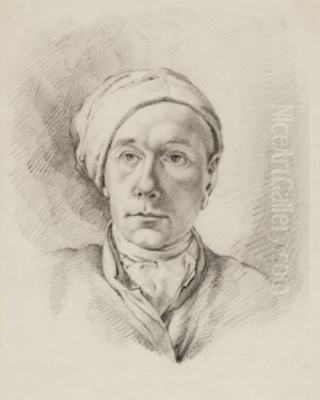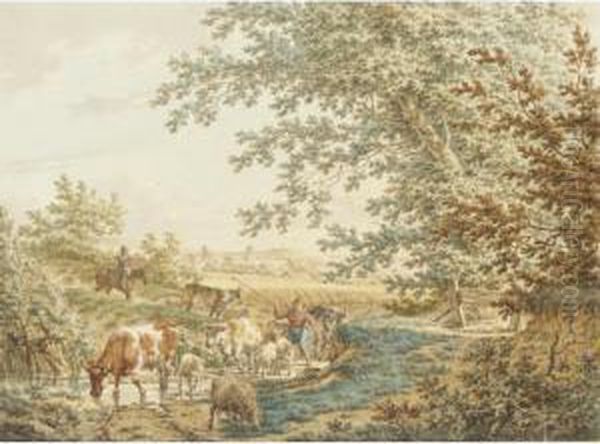
Jacob Cats, born in 1741 in Altona, then a Danish town near Hamburg, and who passed away in Amsterdam in 1799, stands as a significant figure in the Dutch art scene of the latter half of the 18th century. Though perhaps not as universally renowned as some of his Golden Age predecessors, Cats carved a distinct niche for himself as a prolific and skilled painter, draughtsman, and etcher, particularly celebrated for his evocative landscapes, detailed townscapes, and meticulous topographical drawings. His work offers a valuable window into the artistic tastes and practices of his era, demonstrating a continuity of Dutch landscape traditions alongside an individual sensibility.
Early Life and Artistic Formation
Jacob Cats' journey into the art world began under somewhat poignant circumstances. His father, Johannes Cats, was a Dutch bookseller based in Altona. Following the death of his mother, young Jacob moved with his father back to Amsterdam, the bustling heart of Dutch commerce and culture. This relocation would prove pivotal for his artistic development. In Amsterdam, he initially received training in the practical crafts of bookbinding and engraving, skills that likely honed his eye for detail and precision from an early age.
His formal artistic education commenced under the tutelage of Abraham Starre, a lesser-known figure today but presumably a competent instructor in the fundamentals of art. Cats then furthered his studies with Pieter Louw, an artist active in Amsterdam known for his drawings and engravings. It was also noted that he learned pattern design from Gerard van Rossum, a skill that would find application in his early career. This foundational training equipped him with a versatile skill set, blending artistic aspiration with craftsmanship.
From Decorative Arts to Fine Arts

Before establishing himself as an independent artist, Jacob Cats gained practical experience in the decorative arts. Around 1752, or perhaps a little later, he began working as a wallpaper painter at the factory of Jan Hendrik Troost van Groenenoorden in Amsterdam. Wallpaper, or "behangsel," painting was a significant industry, providing luxurious interior decorations for the homes of the affluent. This work, often involving large-scale landscape or pastoral scenes, would have provided Cats with ample practice in composition and the depiction of natural elements.
After several years in this field, supported by relatives, Cats took the entrepreneurial step of establishing his own wallpaper factory around 1759. While this venture provided a livelihood, his passion increasingly leaned towards creating art for its own sake. He gradually transitioned from the large-format, decorative work of wallpaper to the more intimate and detailed creation of easel paintings, drawings, and etchings, which allowed for greater personal expression and artistic exploration.
Capturing the Dutch Vista: Style and Subjects
Jacob Cats is primarily celebrated for his landscape paintings and drawings. His works typically depict the serene Dutch countryside, often featuring pastoral scenes with shepherds and their flocks, tranquil river views, wooded paths, and charming village outskirts. He also produced detailed townscapes, capturing the architectural character of Amsterdam and other locales. His style is characterized by a refined realism, a keen observation of nature, and a delicate rendering of light and atmosphere.
His approach was meticulous, with a strong emphasis on accurate depiction. While his works are rooted in the long tradition of Dutch landscape art, pioneered by masters like Jacob van Ruisdael and Meindert Hobbema in the 17th century, Cats brought an 18th-century sensibility to his subjects – often a more gentle, idyllic, or picturesque quality. He was less concerned with the dramatic or sublime aspects of nature and more focused on its harmonious and accessible beauty. His contemporaries in Dutch landscape and topographical art included figures like Cornelis Pronk, Jan de Beijer, Hendrik Keun, and Izaak Ouwater, all contributing to the visual record of the Netherlands in their era.
The Art of Drawing and Etching
Beyond his oil paintings, Jacob Cats was an exceptionally gifted draughtsman. Many of his most admired works are his drawings, executed with remarkable finesse. He often worked in black chalk, sometimes heightened with white, or used Indian ink washes (grisaille) to create subtle tonal variations and a sense of depth. These drawings were not merely preparatory sketches but were often intended as finished works of art in their own right, eagerly sought after by collectors.
His skill as a draughtsman naturally extended to printmaking. Cats produced a number of etchings, primarily landscapes, which further disseminated his compositions. These prints, like his drawings, showcase his careful attention to detail and his ability to capture the textures of foliage, water, and rustic architecture. The market for prints and drawings was robust in the 18th century, and artists like Cats catered to a growing class of collectors who appreciated these more intimate and often more affordable art forms. His contemporary, Egbert van Drielst, known as "the Hobbema of Drenthe," also excelled in drawing similar rustic landscapes.
Creation Through Recollection
A fascinating aspect of Jacob Cats's artistic practice was his reliance on memory, particularly in his later years. He suffered from severe arthritis, a condition that increasingly hampered his ability to work outdoors, or "en plein air," as was becoming more common for landscape artists. Despite this physical limitation, Cats possessed an extraordinary visual memory. He could recall landscapes he had observed with such clarity that he was able to reconstruct them in his studio with astonishing accuracy and detail.
It is documented that he would sometimes note on the reverse of his drawings that they were created "uyt den geest" (from the mind/memory) or "naar het leven geteekend en uit den geest opgemaakt" (drawn from life and finished from memory). This ability speaks volumes about his deep internalisation of natural forms and his dedication to his craft, overcoming physical adversity to continue producing art. This practice also lends a certain composed, almost idealized quality to some of his later landscapes.
Signature Pieces and Important Series
While a comprehensive catalogue raisonné might be extensive, certain works are frequently cited as representative of Jacob Cats's oeuvre. His painting "Two Shepherds Conversing Before a Large Tree," housed in the Kunsthalle Hamburg, exemplifies his skill in creating balanced pastoral compositions with a focus on the interplay of figures and nature. Another notable work is the drawing "The Wijde Kapelsteeg in Amsterdam" (1793), which demonstrates his proficiency in urban scenery and architectural rendering.
Many of his drawings depict specific locations in and around Amsterdam, Haarlem, and other parts of the Netherlands, serving as valuable topographical records. These include views of city gates, canals, country estates, and rural pathways. His works are found in prestigious collections, including the Rijksmuseum in Amsterdam, the Teylers Museum in Haarlem, and various other public and private collections in the Netherlands and abroad. The artist Paulus van Liender was another contemporary draughtsman known for his topographical views.
Learning from the Masters: Copies and Studies
Like many artists of his time, Jacob Cats honed his skills and expanded his visual vocabulary by studying and copying the works of earlier masters. This practice was a standard part of artistic training and a way for artists to engage with the esteemed traditions of their predecessors. Cats is known to have made copies after celebrated Dutch Golden Age painters.
Among the most famous works he is said to have copied is Rembrandt van Rijn's iconic "The Night Watch." Such an undertaking would have been a formidable challenge, requiring immense skill to replicate the complex composition, lighting, and characterisation of the original. He is also reported to have copied genre scenes, such as "The Poulterer" (or "Chicken Vendor"), a subject popularised by artists like Gerrit Dou. This engagement with the art of the past not only served his own development but also catered to a market for high-quality reproductions of famous paintings. Other artists whose influence can be felt, even if not directly copied, include pastoral specialists like Paulus Potter and masters of light like Aelbert Cuyp.
Contemporaries and Artistic Milieu
Jacob Cats operated within a vibrant, albeit evolving, Dutch art world. While the economic and political power of the Dutch Republic had waned somewhat from its 17th-century zenith, Amsterdam remained an important artistic center. He would have been aware of, and likely interacted with, other artists active in the city. For instance, his prints were sometimes further processed or colored by other artists. One such collaborator was Christiaan Josi (sometimes cited as Christiaan Josias de Vries, though Josi is more established in this context), an engraver and art dealer who is known to have made colored aquatints after Cats's drawings, thereby popularizing them further.
The demand for topographical views was strong, and artists like Johannes Janson also produced landscapes and townscapes that appealed to a similar clientele. The tradition of detailed drawing was upheld by many, and the collection and appreciation of works on paper were significant aspects of 18th-century Dutch art culture. Cats's dedication to craftsmanship and his focus on the native landscape placed him firmly within this continuing tradition. The work of Adriaen van de Velde, an earlier master of pastoral landscapes, also provided a rich source of inspiration for later generations.
Enduring Legacy and Collections
Jacob Cats's legacy lies in his contribution to the Dutch landscape and topographical tradition in the 18th century. His works are valued for their technical skill, their charming depiction of the Dutch environment, and their historical significance as records of places and a way of life. He successfully navigated the transition from decorative wallpaper painting to a career as an independent fine artist, demonstrating versatility and dedication.
His drawings, in particular, are highly esteemed by connoisseurs and are well-represented in major print rooms and museums. The meticulous detail and atmospheric quality of his landscapes continue to appeal to viewers today. While he may not have been a radical innovator in the vein of some earlier Dutch masters, his consistent output of high-quality work ensured his reputation among his contemporaries and secured his place in the annals of Dutch art. His art reflects a period of consolidation and refinement in Dutch art, rather than groundbreaking change, yet it possesses an enduring charm and technical proficiency. The influence of earlier artists like Philips Wouwerman, known for his landscapes with horses and figures, can also be seen as part of the broader artistic heritage that informed Cats and his contemporaries.
Conclusion
Jacob Cats (1741-1799) was a dedicated and talented artist who made a significant contribution to Dutch art in the latter 18th century. From his beginnings in Altona and his training in Amsterdam to his establishment as a respected painter and draughtsman, he exemplified the diligent craftsmanship and keen observational skills that characterized the best of Dutch landscape art. His ability to work from memory when afflicted by arthritis is a testament to his profound connection with his subject matter. Through his detailed landscapes, townscapes, and pastoral scenes, Jacob Cats not only captured the visual essence of his native Holland but also left behind a body of work that continues to be appreciated for its artistry and historical value. He remains an important figure for understanding the continuation and adaptation of Dutch artistic traditions in an era of change.